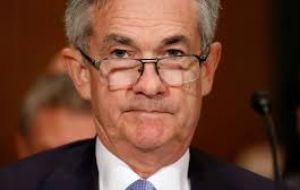MercoPress. South Atlantic News Agency
Fed leaves benchmark interest rate unchanged; core PCE climbs to 2% in second quarter
 The stance of monetary policy remains accommodative, supporting strong labor market conditions and a sustained return to 2% inflation
The stance of monetary policy remains accommodative, supporting strong labor market conditions and a sustained return to 2% inflation  Fed's preferred measure of inflation, Personal Consumption Expenditures price index excluding food and energy components, increased at a 2% pace in the 2Q
Fed's preferred measure of inflation, Personal Consumption Expenditures price index excluding food and energy components, increased at a 2% pace in the 2Q The Federal Reserve held its benchmark interest rate unchanged on Wednesday and reaffirmed its plans to continue raising borrowing costs at a gradual pace. The decision to hold rates had been widely expected and came after a two-day meeting of the Federal Open Market Committee, which dictates monetary policy.
Traders expect the Fed to raise borrowing costs twice more this year. They see a 92% probability that it will raise the fed funds rate to a range of 2% to 2.25% in September, according to Bloomberg.
“Economic activity has been rising at a strong rate,” the Fed's statement said, thanks to strong household spending and business investment. An advance estimate of second quarter GDP released on Friday showed that the economy grew at an annualized rate of 4.1%, the fastest in nearly four years.
During his semiannual congressional testimony in mid-July, Fed Chairman Jerome Powell said that, with appropriate monetary policy, the job market would remain strong and inflation would stay around the 2% target for “several years.”
He said that it was difficult to predict the outcome of the ongoing trade disputes but that a prolonged trade war would hurt the economy.
With seven rate hikes in the bag since the financial crisis, the Fed is contemplating whether to remove language in its statement that continues to describe borrowing costs as low. Minutes of its meeting in June showed that some FOMC officials debated how communications may evolve if the economy continued to make progress and was able to withstand higher rates.
One of the outstanding indicators, inflation is perking up after six years of undershooting the Fed's target. The central bank's preferred measure of inflation - the personal consumption expenditures (PCE) price index excluding food and energy components - increased at a 2.0 per cent pace in the second quarter.
The latest monthly figures released on Tuesday showed the core PCE in June was 1.9% higher than a year ago. That measure hit the central bank's inflation target in March for the first time since December 2011.
US labor costs, viewed as one of the better gauges of how much slack is left in the market, also posted their largest annual gain since 2008 in the second quarter, the Labor Department said on Tuesday.
Wednesday's policy statement made no mention of the administration's protectionist trade policies and maintained that the risks to the outlook were “roughly balanced.”
Here's the Fed's statement:
“Information received since the Federal Open Market Committee met in June indicates that the labor market has continued to strengthen and that economic activity has been rising at a strong rate. Job gains have been strong, on average, in recent months, and the unemployment rate has stayed low. Household spending and business fixed investment have grown strongly. On a 12-month basis, both overall inflation and inflation for items other than food and energy remain near 2%. Indicators of longer-term inflation expectations are little changed, on balance.
”Consistent with its statutory mandate, the Committee seeks to foster maximum employment and price stability. The Committee expects that further gradual increases in the target range for the federal funds rate will be consistent with sustained expansion of economic activity, strong labor market conditions, and inflation near the Committee's symmetric 2% objective over the medium term. Risks to the economic outlook appear roughly balanced.
“In view of realized and expected labor market conditions and inflation, the Committee decided to maintain the target range for the federal funds rate at 1-3/4 to 2 percent. The stance of monetary policy remains accommodative, thereby supporting strong labor market conditions and a sustained return to 2 percent inflation.
”In determining the timing and size of future adjustments to the target range for the federal funds rate, the Committee will assess realized and expected economic conditions relative to its maximum employment objective and its symmetric 2% inflation objective. This assessment will take into account a wide range of information, including measures of labor market conditions, indicators of inflation pressures and inflation expectations, and readings on financial and international developments.
“Voting for the FOMC monetary policy action were: Jerome H. Powell, Chairman; John C. Williams, Vice Chairman; Thomas I. Barkin; Raphael W. Bostic; Lael Brainard; Esther L. George; Loretta J. Mester; and Randal K. Quarles.”




Top Comments
Disclaimer & comment rulesCommenting for this story is now closed.
If you have a Facebook account, become a fan and comment on our Facebook Page!